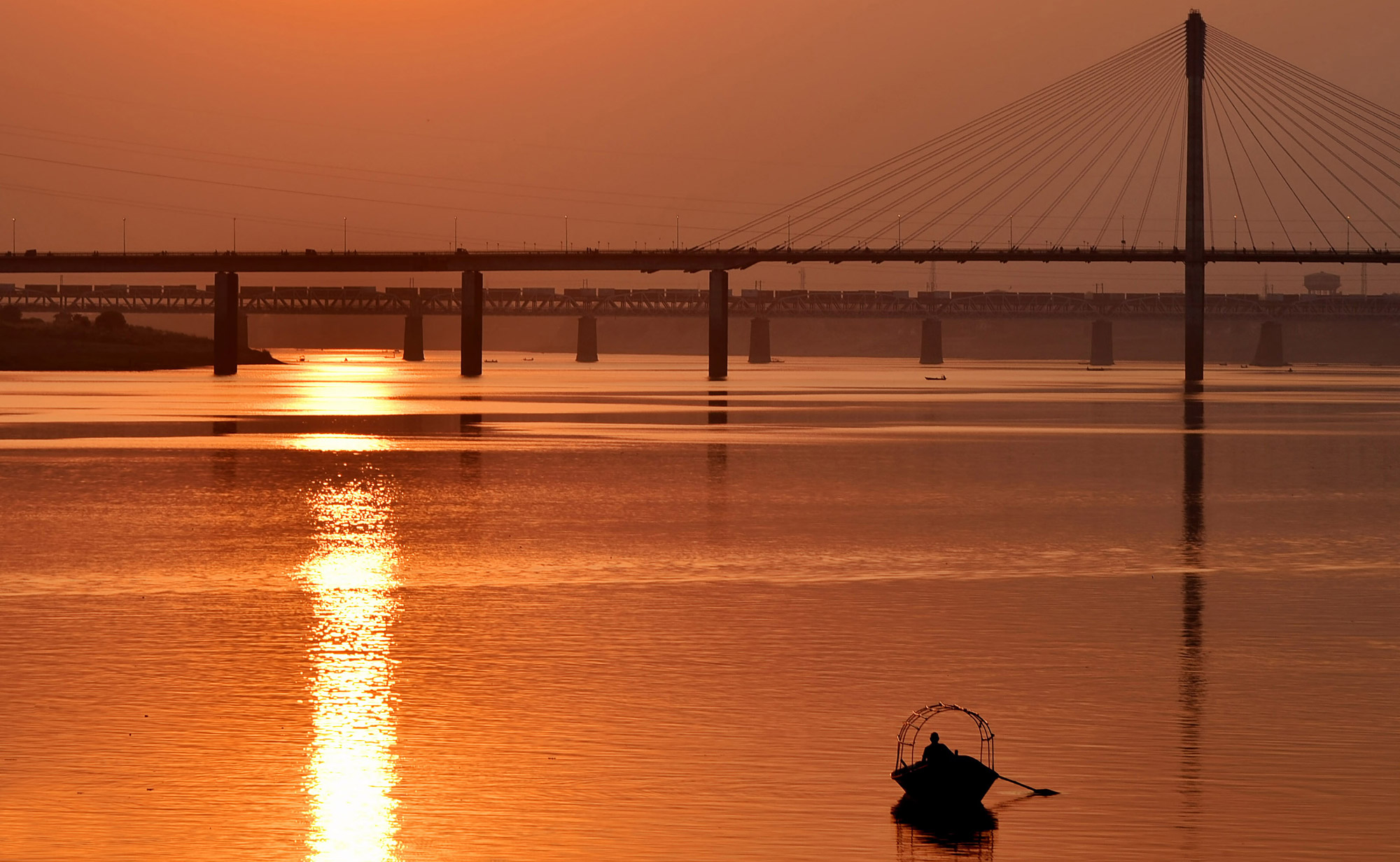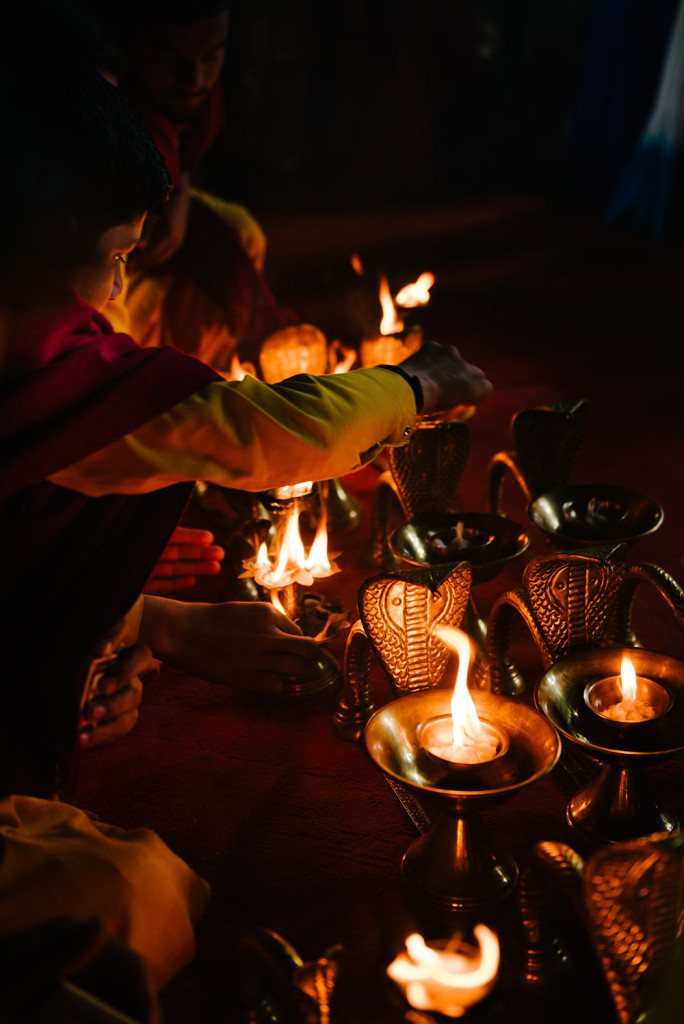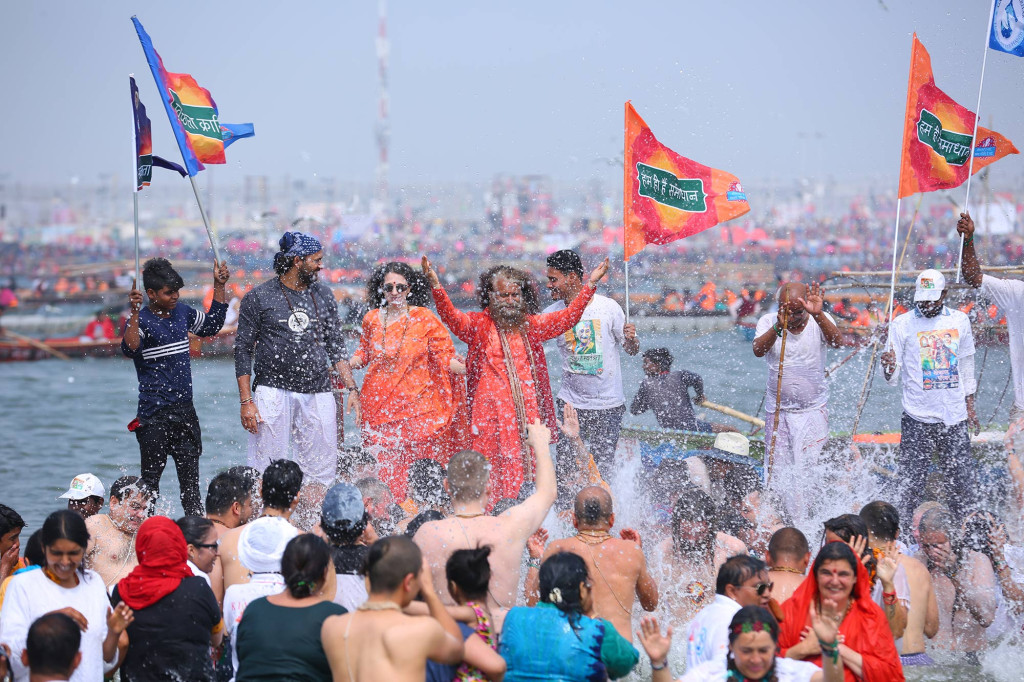
Kumbha Mela is one of the most ancient, yet still living, traditions of India’s glorious past. The festival dates back to the pre-Vedic period, as even in the Vedas, the Kumbha Mela is described as a tradition that has already existed and was well established. The popularity of the Kumbha has only increased over the millennia, gathering millions together every 12 years at each of the four holy places in which the auspicious event occurs, making it the world’s largest gathering of people on Earth for one common purpose.
It has also been declared a UNESCO World Heritage event. It is said that even those saints and sages who live in divine isolation, high in the Himalayas, engaged only in meditation and austerities, emerge from the mountains to attend. The Kumbha is a world-renowned symbol of India’s proud antiquity and is a matchlessly divine occasion.
Spanning a period from January through February, the 2025 Purna (Full) Kumbha Mela will take place in Prayagraj (the city of God), a divine location situated at the confluence of the three sacred rivers: Ganga, Yamuna, and Saraswati.

In essence, the Kumbh Mela is not just a religious event but a celebration of humanity, promoting values that transcend religious and cultural boundaries.
In essence, the Kumbh Mela is not just a religious event but a celebration of humanity, promoting values that transcend religious and cultural boundaries.

One author describes the Kumbha Mela:
“To watch the Kumbha Mela procession is to witness the march of the ages. As the holy saints pass by on their various and sundry conveyances—elephants, horses, chariots, cars, and camels—they continually transmit waves of powerful shakti (energy) to all the people who witness this awe-inspiring and most auspicious event. Devotees are overwhelmed by the palpable spiritual vibrations that pervade the entire atmosphere.
As the parade of saints marches towards the River Ganges, the sounds baffle all description. The shouts and cries of ash-smeared sadhus mingle with the neighing of horses, trumpeting of elephants, grunting of camels, bellowing of bulls, gongs, drum beats, trumpets blare, conch shells, and bells ring.”
Amidst all this pomp and magnificence, one can drink in the nectar of India’s ancient spiritual tradition. No matter where you go within the Mela, there will be people of various ages and sizes sitting in satsang, bathing in the sacred rivers, meditating on the banks, engaging in yogic practices, attending yoga classes, chanting mantras, performing yajnas, and singing bhajans. Even the 330 million Gods and Goddesses of Indian tradition are said to attend the Mela on the inner planes. Every corner of the Mela is permeated with ancient tradition and spirituality.
After visiting the Kumbha Mela of 1895, the famous author Mark Twain wrote:
“It is wonderful, the power of faith like that can make multitudes of the old and the weak and the young and the frail without hesitation or complaint upon such an incredible journey and endure the resultant miseries without repining. It is not done in love, or it is done in fear; I do not know which it is. No matter what the impulse is, the act of it is beyond imagination, marvelous to our kind of people…”
A new “city” is erected at the time of the Kumbha Mela, a temporary city of tents to house millions of pilgrims who flock there. This year, between 400 million people are expected to arrive in Prayagraj for the occasion.
Significance of the Upcoming Kumbh Mela
The upcoming Kumbh Mela will be held in Prayagraj in 2025. This event is particularly significant as it is considered the Maha Kumbh Mela, which happens once every 144 years (12 Kumbh cycles). The confluence of the Ganga, Yamuna, and the mythical Saraswati rivers in Prayagraj is especially auspicious, making this Kumbh Mela a highly revered occasion.
The significance of the Kumbh Mela lies not just in its mythological roots but also in its cultural, spiritual, and social aspects. It serves as a meeting ground for millions of pilgrims, sadhus (holy men), and spiritual leaders from various traditions. The gathering is a great testament to the power of faith, a celebration of cultural and spiritual heritage of India, and brings about a great sense of unity among participants.

Message and Purpose of the Kumbh Mela
The Kumbh Mela carries a profound message of introspection, purification, and spiritual growth. It is an opportunity for individuals to reflect on their lives, seek divine blessings, and commit to leading a more righteous and fulfilling life. The act of taking a dip in the sacred rivers symbolizes the washing away of past sins and the start on the path to true liberation in this lifetime.
Moreover, the Kumbh Mela embodies the ideals of unity, peace, and cooperation among diverse groups of people. It showcases India’s rich cultural heritage and spiritual traditions to the world, emphasizing the importance of faith, devotion, and the collective human spirit.
In essence, the Kumbh Mela is not just a religious event but a celebration of humanity, promoting values that transcend religious and cultural boundaries.


The Mythological Background of Kumbha
Kumbh Mela is rooted in the mythological story of the churning of the ocean, known as Samudra Manthan, conducted by Gods and demons to obtain the nectar of immortality. In this process, the Mandarachal Mountain was used as a churning rod, and the serpent Vasuki served as the rope. Lord Vishnu took the form of a tortoise (Kurma avatar) to provide a stable base for the Mandarachal Mountain.
During the churning, the first substance to emerge was the deadly poison Halahal, which Lord Shiva absorbed in his throat, earning him the name Neelkanth (the blue-throated one). Following the poison, various unique treasures emerged, including Kamadhenu, the wish-fulfilling cow. Eventually, Lord Dhanvantari appeared, carrying the pot of nectar (Amrit). Jayant, the son of Lord Indra, seized the nectar pot from Lord Dhanvantari.
Seeing this, Shukracharya, the Guru of the demons, urged the demons to chase Jayant. According to divine calculations, one day of the Gods is equal to one year of a human being. Jayant kept running for 12 days to protect the Amrit Kalash from the demons. During these divine 12 days, equivalent to 12 human years, Jayant rested at four places where drops of nectar spilled: Haridwar, Prayag, Nashik-Trimbakeshwar, and Ujjain. It is believed that these drops imparted miraculous powers to these holy places. Since then, the Maha Kumbh Mela is organized at these divine sites once every 12 years.
The Mythological Background of Kumbha
Kumbh Mela is rooted in the mythological story of the churning of the ocean, known as Samudra Manthan, conducted by Gods and demons to obtain the nectar of immortality. In this process, the Mandarachal Mountain was used as a churning rod, and the serpent Vasuki served as the rope. Lord Vishnu took the form of a tortoise (Kurma avatar) to provide a stable base for the Mandarachal Mountain.
During the churning, the first substance to emerge was the deadly poison Halahal, which Lord Shiva absorbed in his throat, earning him the name Neelkanth (the blue-throated one). Following the poison, various unique treasures emerged, including Kamadhenu, the wish-fulfilling cow. Eventually, Lord Dhanvantari appeared, carrying the pot of nectar (Amrit). Jayant, the son of Lord Indra, seized the nectar pot from Lord Dhanvantari.
Seeing this, Shukracharya, the Guru of the demons, urged the demons to chase Jayant. According to divine calculations, one day of the Gods is equal to one year of a human being. Jayant kept running for 12 days to protect the Amrit Kalash from the demons. During these divine 12 days, equivalent to 12 human years, Jayant rested at four places where drops of nectar spilled: Haridwar, Prayag, Nashik-Trimbakeshwar, and Ujjain. It is believed that these drops imparted miraculous powers to these holy places. Since then, the Maha Kumbh Mela is organized at these divine sites once every 12 years.
Further Information
The Kumbh Mela in 2025 will be held in Prayagraj, with the festival starting on January 13 and concluding on February 26. Here are the significant bathing dates, including the Shahi Snan (royal baths):
Shahi Snan Dates:
January 14, 2025 – Makar Sankranti
January 29, 2025 – Mauni Amavasya
February 3, 2025 – Basant Panchami
Additional Important Snan Dates:
January 13, 2025 – Paush Purnima
February 4, 2025 – Achla Saptami
February 12, 2025 – Maghi Purnima
February 26, 2025 – Maha Shivratri
These dates are essential for pilgrims who wish to participate in the sacred rituals of the Kumbh Mela.
1. Haridwar: Along the National River Ganga
2. Prayagraj (considered the most auspicious of them all): Along the confluence of the Ganga, Yamuna, and Saraswati
3. Nashik-Trimbakeshwar: Along the Godavari River
4. Ujjain: Along the Kshipra River (the celebration is better known as the Simhastha)
Jupiter holds a significant place in the astrological calculation of Kumbh Mela. Jupiter stays in one zodiac sign for about a year, taking 12 years to travel through all twelve zodiac signs. This cycle is why Kumbh Mela returns to the same place every twelve years. According to astrological calculations, the importance of Kumbh Mela is also associated with specific planetary positions: Jupiter’s entry into Aquarius (Kumbh) and the Sun’s entry into Aries (Mesha).




